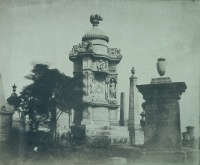Cemetery
From The Art and Popular Culture Encyclopedia
_.jpg)
.png)
|
Related e |
|
Featured: |
A cemetery is a place in which dead bodies and cremated remains are buried. The term cemetery (from Greek κοιμητήριον: sleeping place) implies that the land is specifically designated as a burying ground. Cemeteries in the Western world are the place where the final ceremonies of death are observed. These ceremonies or rites differ according to cultural practice and religious belief.
Modernity
Starting in the early 19th century, the burial of the dead in graveyards began to be discontinued, due to rapid population growth in the early stages of the Industrial Revolution, continued outbreaks of infectious disease near graveyards and the increasingly limited space in graveyards for new interments. In many European states, burial in graveyards was eventually outlawed altogether through legislation.
Instead of graveyards, completely new places of burial were established away from heavily populated areas and outside of old towns and city centers. Many new cemeteries became municipally owned or were run by their own corporations, and thus independent from churches and their churchyards.
In some cases, skeletons were exhumed from graveyards and moved into ossuaries or catacombs. A large action of this type occurred in 18th century Paris when human remains were transferred from graveyards all over the city to the Catacombs of Paris. The bones of an estimated 6 million people are to be found there.
An early example of a landscape-style cemetery is Père Lachaise in Paris. This embodied the idea of state- rather than church-controlled burial, a concept that spread through the continent of Europe with the Napoleonic invasions. This could include the opening of cemeteries by private or joint stock companies. The shift to municipal cemeteries or those established by private companies was usually accompanied by the establishing of landscaped burial grounds outside the city (e.g. extramural).
In Britain the movement was driven by dissenters and public health concerns. The Rosary Cemetery in Norwich was opened in 1819 as a burial ground for all religious backgrounds. Similar private non-denominational cemeteries were established near industrialising towns with growing populations, such as Manchester (1821) and Liverpool (1825). Each cemetery required a separate Act of Parliament for authorisation, although the capital was raised through the formation of joint-stock companies.
In the first 50 years of the 19th century the population of London more than doubled from 1 million to 2.3 million. The small parish churchyards were rapidly becoming dangerously overcrowded, and decaying matter infiltrating the water supply was causing epidemics. The issue became particularly acute after the cholera epidemic of 1831, which killed 52,000 people in Britain alone, putting unprecedented pressure on the country's burial capacity. Concerns were also raised about the potential public health hazard arising from the inhalation of gases generated from human putrefaction under the then prevailing miasma theory of disease.
Legislative action was slow in coming, but in 1832 Parliament finally acknowledged the need for the establishment of large municipal cemeteries and encouraged their construction outside London. The same bill also closed all inner London churchyards to new deposits. The Magnificent Seven, seven large cemeteries around London, were established in the following decade, starting with Kensal Green in 1832.
Urban planner and author John Claudius Loudon was one of the first professional cemetery designers, and his book On the Laying Out, Planting and Managing of Cemeteries (1843) was very influential on designers and architects of the period. Loudon himself designed three cemeteries – Bath Abbey Cemetery, Histon Road Cemetery, Cambridge, and Southampton Old Cemetery.
The Metropolitan Burial Act of 1852 legislated for the establishment of the first national system of government-funded municipal cemeteries across the country, opening the way for a massive expansion of burial facilities throughout the late 19th century.
In the United States, rural cemeteries became recreational areas in a time before public parks, hosting events from casual picnics to hunts and carriage races.
See also
- Corpse road
- Pet cemetery
- Catacomb
- Churchyard
- Columbarium
- Crypt
- Grave field
- Mass grave
- Necropolis
- Ossuary
- Tomb
- Tumulus
- Unmarked grave
- War grave
.jpg)

..jpg)

